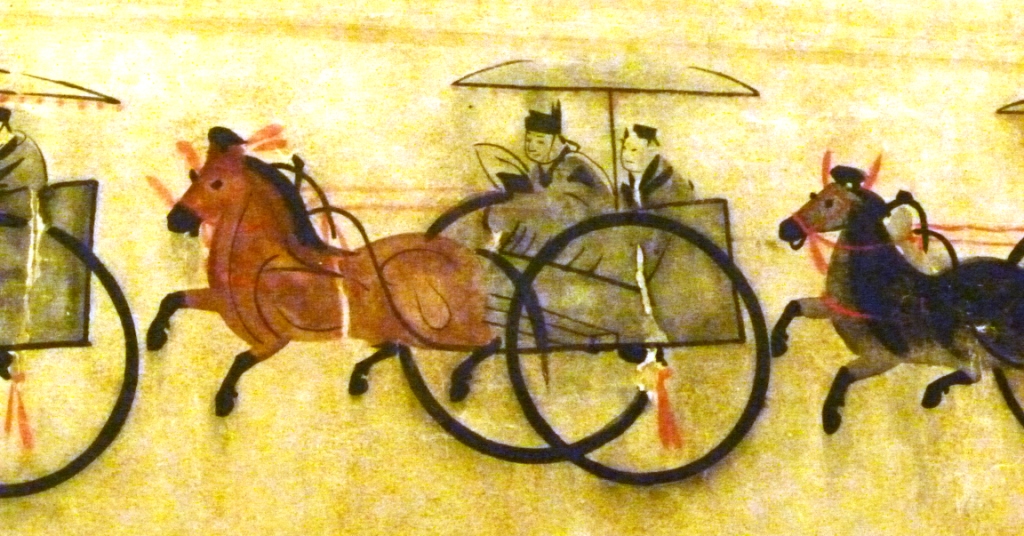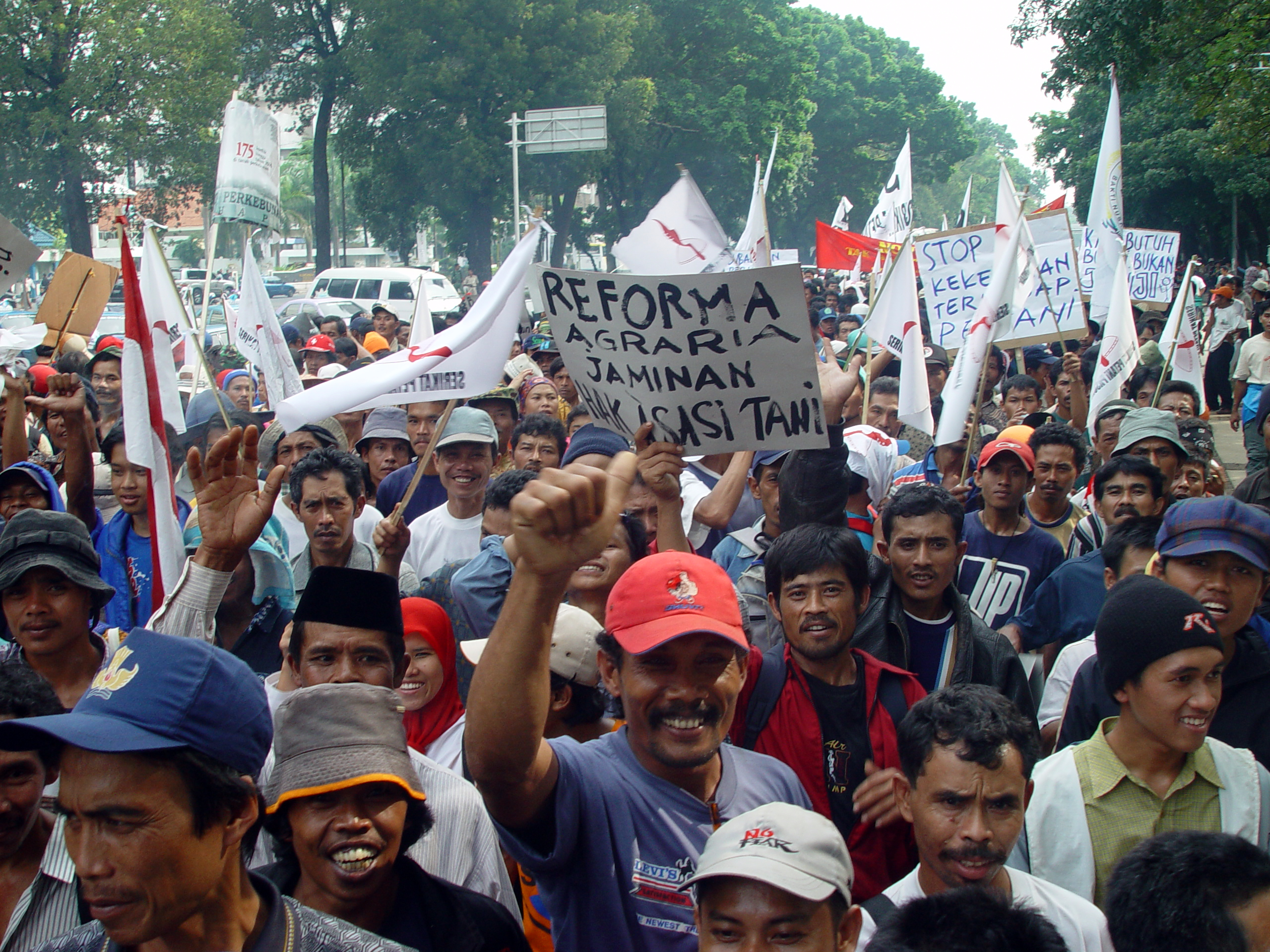|
Agricultural Land Reform Code
The Agricultural Land Reform Code, officially designated as Republic Act No. 3844, was an advancement of land reform in the Philippines that was enacted in 1963 under President Diosdado Macapagal. It abolished tenancy and established a leasehold system in which farmers paid fixed rentals to landlords, rather than a percentage of harvest. In agricultural leasehold, the farmer cultivates the land belonging to, or possessed by, another with the latter's consent for a price certain in money or in produce or both. It also established the Land Bank of the Philippines to help with land reform, particularly the purchase of agricultural estates for division and resale to small landholders, and the purchase of land by the agricultural lessee. While the law was a significant advance over previous legislation, the bill was weakened by numerous amendments imposed by Congress, which was dominated by landlords. It was also weakened by the failure of Congress to allocate necessary funds for effect ... [...More Info...] [...Related Items...] OR: [Wikipedia] [Google] [Baidu] |
Land Reform In The Philippines
Land reform in the Philippines has long been a contentious issue rooted in the Philippines's History of the Philippines (1521–1898), Spanish Colonial Period. Some efforts began during the American Colonial Period with renewed efforts during the Commonwealth, following independence, during Martial Law and especially following the People Power Revolution in 1986. The current law, the Comprehensive Agrarian Reform Program, was passed following the revolution and recently extended until 2014. History Much like Mexico and other Spanish colonization of the Americas, Spanish colonies in the Americas, the Spanish settlement in the Philippines revolved around the encomienda system of plantations, known as haciendas. As the 19th Century progressed, industrialization and liberalization of trade allowed these encomiendas to expand their cash crops, establishing a strong Sugar industry of the Philippines, sugar industry in the Philippines, especially in the Visayas, Visayan island of Negro ... [...More Info...] [...Related Items...] OR: [Wikipedia] [Google] [Baidu] |
Diosdado Macapagal
Diosdado Pangan Macapagal Sr. (; September 28, 1910 – April 21, 1997) was a Filipino lawyer, poet and politician who served as the ninth president of the Philippines, serving from 1961 to 1965, and the sixth vice president, serving from 1957 to 1961. He also served as a member of the House of Representatives, and headed the Constitutional Convention of 1970. He was the father of Gloria Macapagal Arroyo, who followed his path as president of the Philippines from 2001 to 2010. A native of Lubao, Pampanga, Macapagal graduated from the University of the Philippines and University of Santo Tomas, both in Manila, after which he worked as a lawyer for the government. He first won election in 1949 to the House of Representatives, representing the 1st district in his home province of Pampanga. In 1957, he became vice president under the rule of President Carlos P. Garcia, whom he later defeated in the 1961 election. As president, Macapagal worked to suppress graft and corruption ... [...More Info...] [...Related Items...] OR: [Wikipedia] [Google] [Baidu] |
Land Bank Of The Philippines
Land Bank of the Philippines (LBP; often referred to simply as LandBank), is a government-owned bank in the Philippines with a special focus on serving the needs of farmers and fishermen. While it provides the services of a universal bank, it is officially classified as a "specialized government bank" with a universal banking license. LandBank is the second largest bank in the Philippines in terms of assets and is the largest government-owned bank. It is also one of the biggest government-owned and controlled corporations and banking institutions in the Philippines along with the Development Bank of the Philippines (DBP), Overseas Filipino Bank (OFW Bank), and Al-Amanah Islamic Investment Bank of the Philippines. Unlike most Philippine banks, LandBank has an extensive rural branch network with 409 Branches and Extension Offices, 46 Lending Centers and 2,188 ATMs (as of February 2020). It services many rural sector clients in areas where banking is either limited to rural bank ... [...More Info...] [...Related Items...] OR: [Wikipedia] [Google] [Baidu] |
Congress Of The Philippines
The Congress of the Philippines ( fil, Kongreso ng Pilipinas, italic=unset) is the legislature of the national government of the Philippines. It is bicameral, composed of a lower body, the House of Representatives of the Philippines, House of Representatives, although colloquially the term "Congress" commonly refers to just the latter, and an upper body, the Senate of the Philippines, Senate. The House of Representatives meets in the Batasang Pambansa Complex, Batasang Pambansa in Quezon City while the Senate meets in the GSIS Building in Pasay. The Senate is composed of 24 senators half of which are elected every three years. Each senator, therefore, serves a total of six years. The senators are elected at-large and do not represent any geographical district. In the current 19th Congress of the Philippines, 19th Congress, there are 316 seats in the House of Representatives. The Constitution of the Philippines, Constitution states that the House "shall be composed of not more ... [...More Info...] [...Related Items...] OR: [Wikipedia] [Google] [Baidu] |
Landlord
A landlord is the owner of a house, apartment, condominium, land, or real estate which is rented or leased to an individual or business, who is called a tenant (also a ''lessee'' or ''renter''). When a juristic person is in this position, the term landlord is used. Other terms include lessor and owner. The term landlady may be used for the female owners. The manager of a pub in the United Kingdom, strictly speaking a licensed victualler, is referred to as the landlord/landlady. In political economy it refers to the owner of natural resources alone (e.g., land, not buildings) from which an economic rent is the income received. History The concept of a landlord may be traced back to the feudal system of manoralism (seignorialism), where a landed estate is owned by a Lord of the Manor (mesne lords), usually members of the lower nobility which came to form the rank of knights in the high medieval period, holding their fief via subinfeudation, but in some cases the land may also ... [...More Info...] [...Related Items...] OR: [Wikipedia] [Google] [Baidu] |
Department Of Agrarian Reform
The Department of Agrarian Reform ( fil, Kagawaran ng Repormang Pansakahan}, abbreviated as DAR or KRP) is an executive department of the Philippine government responsible for the redistribution of agrarian land in the Philippines. List of the Secretaries of the Department of Agrarian Reform Bureaus * Bureau of Agrarian Reform Legal Assistance * Bureau of Agrarian Reform Beneficiaries Development * Bureau of Land Tenure Improvement * Bureau of Land Development * Bureau of Agrarian Reform Information Education References External links Department of Agrarian Reform websiteDAR – History {{authority control 1971 establishments in the Philippines Philippines, Agrarian Reform Philippines, Agrarian Reform Agrarian Reform Agrarian reform can refer either, narrowly, to government-initiated or government-backed redistribution of agricultural land (see land reform) or, broadly, to an overall redirection of the agrarian system of the country, which often includes lan ... [...More Info...] [...Related Items...] OR: [Wikipedia] [Google] [Baidu] |
Comprehensive Agrarian Reform Program
The Comprehensive Agrarian Reform Program, more commonly known as CARP, is an agrarian reform law of the Philippines whose legal basis is the Republic Act No. 6657, otherwise known as the Comprehensive Agrarian Reform Law (CARL). It is the redistribution of private and public agricultural lands to help the beneficiaries survive as small independent farmers, regardless of the “tenurial” arrangement. Its goals are to provide landowners equality in terms of income and opportunities, empower land owner beneficiaries to have equitable land ownership, enhance agricultural production and productivity, provide employment to more agricultural workers, and put an end to conflicts regarding land ownership. Background The agrarian reform is part of the long history of attempts of land reform in the Philippines. The law was outlined by former President Corazon C. Aquino through Presidential Proclamation 131 and Executive Order 229 on June 22, 1987, and it was enacted by the 8th Congress of ... [...More Info...] [...Related Items...] OR: [Wikipedia] [Google] [Baidu] |
Land Reform In The Philippines
Land reform in the Philippines has long been a contentious issue rooted in the Philippines's History of the Philippines (1521–1898), Spanish Colonial Period. Some efforts began during the American Colonial Period with renewed efforts during the Commonwealth, following independence, during Martial Law and especially following the People Power Revolution in 1986. The current law, the Comprehensive Agrarian Reform Program, was passed following the revolution and recently extended until 2014. History Much like Mexico and other Spanish colonization of the Americas, Spanish colonies in the Americas, the Spanish settlement in the Philippines revolved around the encomienda system of plantations, known as haciendas. As the 19th Century progressed, industrialization and liberalization of trade allowed these encomiendas to expand their cash crops, establishing a strong Sugar industry of the Philippines, sugar industry in the Philippines, especially in the Visayas, Visayan island of Negro ... [...More Info...] [...Related Items...] OR: [Wikipedia] [Google] [Baidu] |
Land Reform
Land reform is a form of agrarian reform involving the changing of laws, regulations, or customs regarding land ownership. Land reform may consist of a government-initiated or government-backed property redistribution, generally of agricultural land. Land reform can, therefore, refer to transfer of ownership from the more powerful to the less powerful, such as from a relatively small number of wealthy or noble owners with extensive land holdings (e.g., plantations, large ranches, or agribusiness plots) to individual ownership by those who work the land. Such transfers of ownership may be with or without compensation; compensation may vary from token amounts to the full value of the land. Land reform may also entail the transfer of land from individual ownership—even peasant ownership in smallholdings—to government-owned collective farms; it has also, in other times and places, referred to the exact opposite: division of government-owned collective farms into smallholdings. Th ... [...More Info...] [...Related Items...] OR: [Wikipedia] [Google] [Baidu] |
Agriculture In The Philippines
Agriculture in the Philippines is an important part of the economy of the Philippines with crops like rice, coconut and sugar dominating the production of crops and exports. It employs 23% of the Filipino workforce , according to the World Bank. The Philippines is one of the most vulnerable agricultural systems to monsoons and other extreme weather events, which are expected to create more uncertainty as climate change effects the Philippines. However, the Food and Agriculture Organization has described the local policy measures as some of the most proactive in risk reduction. History Profession Grains Rice The Philippines is the 8th largest rice producer in the world, accounting for 2.8% of global rice production. The Philippines was also the world's largest rice importer in 2010. In 2010, nearly 15.7 million metric tons of palay (pre-husked rice) were produced. In 2010, ''palay'' accounted for 21.86% percent of gross value added in agriculture and 2.37% of G ... [...More Info...] [...Related Items...] OR: [Wikipedia] [Google] [Baidu] |
Philippine Legislation
The Philippines (; fil, Pilipinas, links=no), officially the Republic of the Philippines ( fil, Republika ng Pilipinas, links=no), * bik, Republika kan Filipinas * ceb, Republika sa Pilipinas * cbk, República de Filipinas * hil, Republika sang Filipinas * ibg, Republika nat Filipinas * ilo, Republika ti Filipinas * ivv, Republika nu Filipinas * pam, Republika ning Filipinas * krj, Republika kang Pilipinas * mdh, Republika nu Pilipinas * mrw, Republika a Pilipinas * pag, Republika na Filipinas * xsb, Republika nin Pilipinas * sgd, Republika nan Pilipinas * tgl, Republika ng Pilipinas * tsg, Republika sin Pilipinas * war, Republika han Pilipinas * yka, Republika si Pilipinas In the recognized optional languages of the Philippines: * es, República de las Filipinas * ar, جمهورية الفلبين, Jumhūriyyat al-Filibbīn is an archipelagic country in Southeast Asia. It is situated in the western Pacific Ocean and consists of around 7,641 islands t ... [...More Info...] [...Related Items...] OR: [Wikipedia] [Google] [Baidu] |


